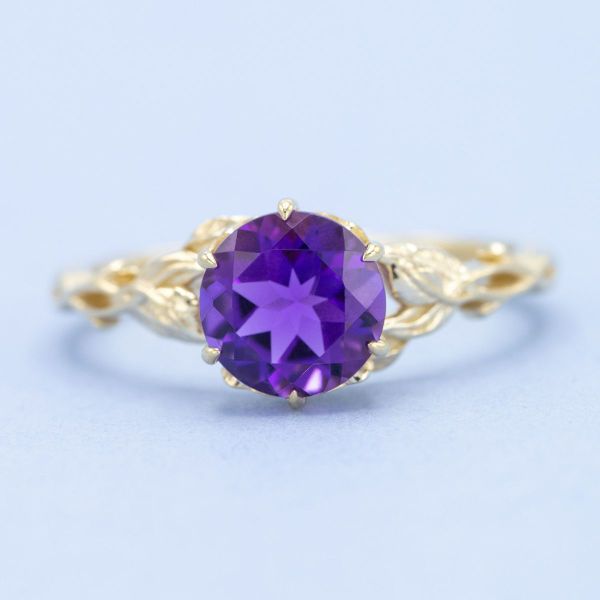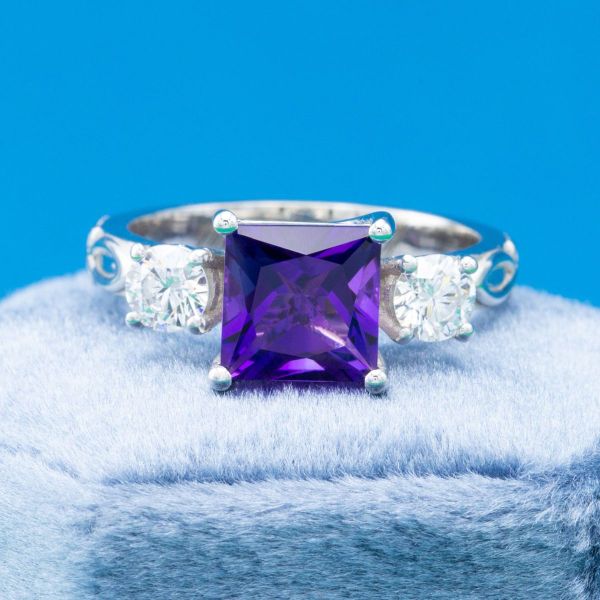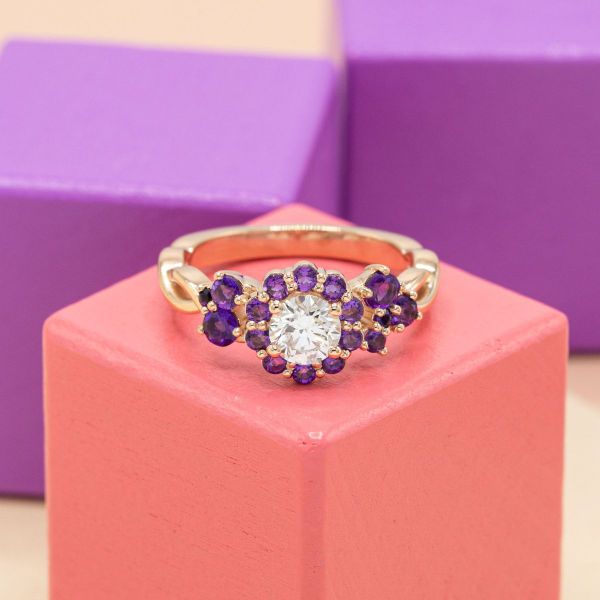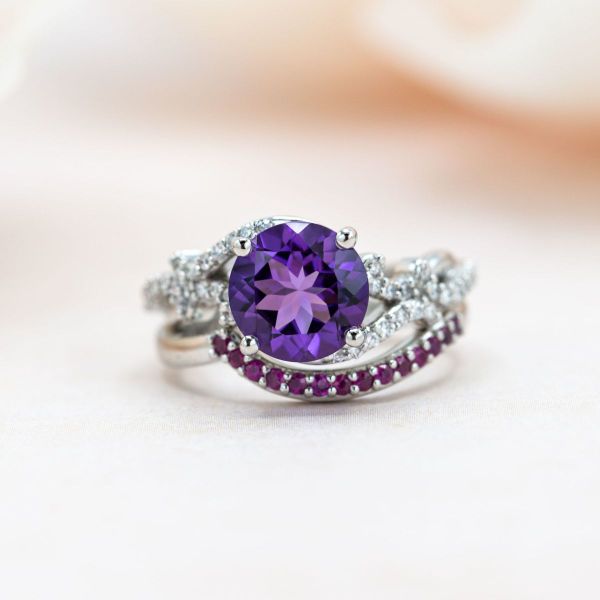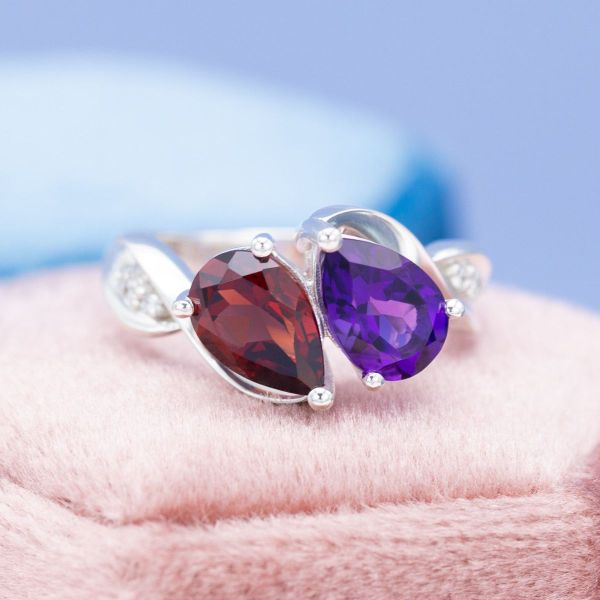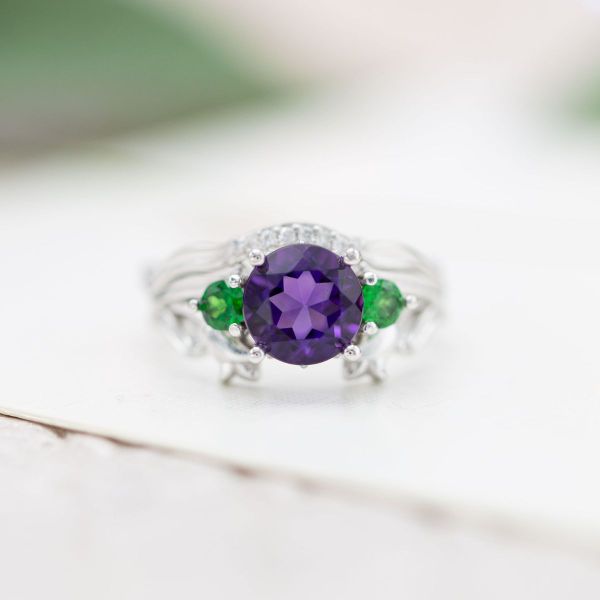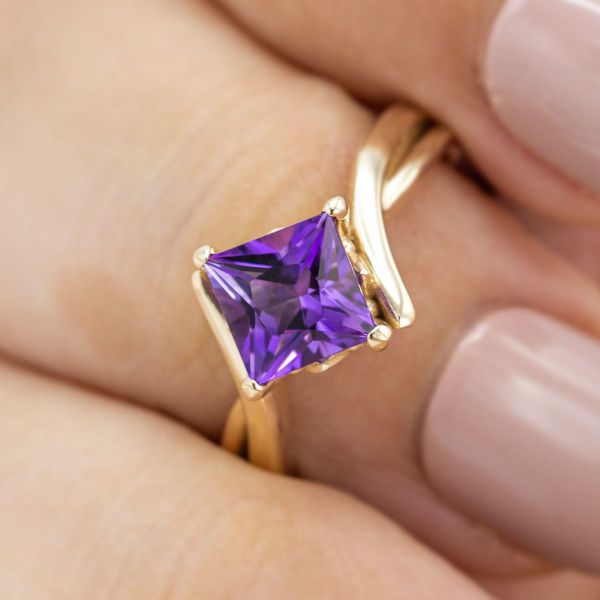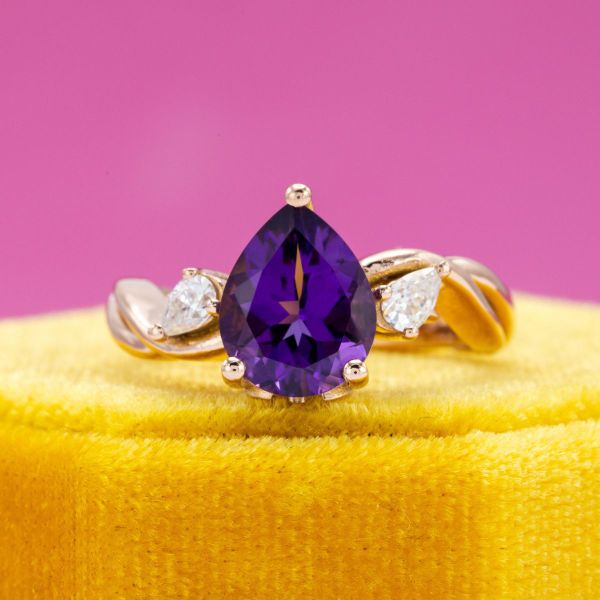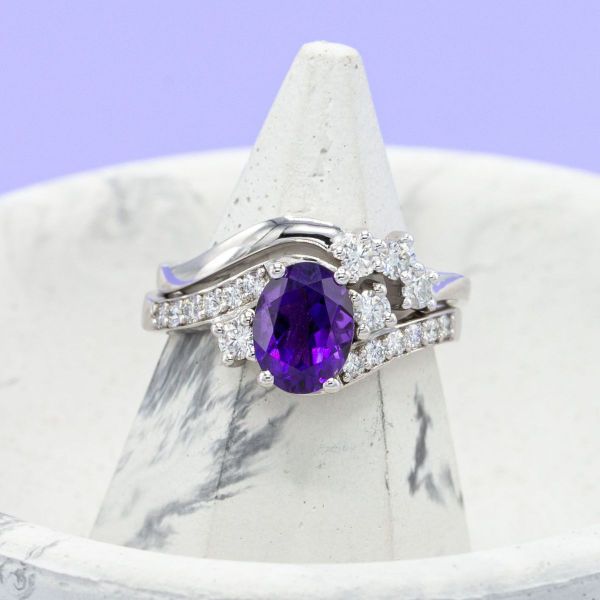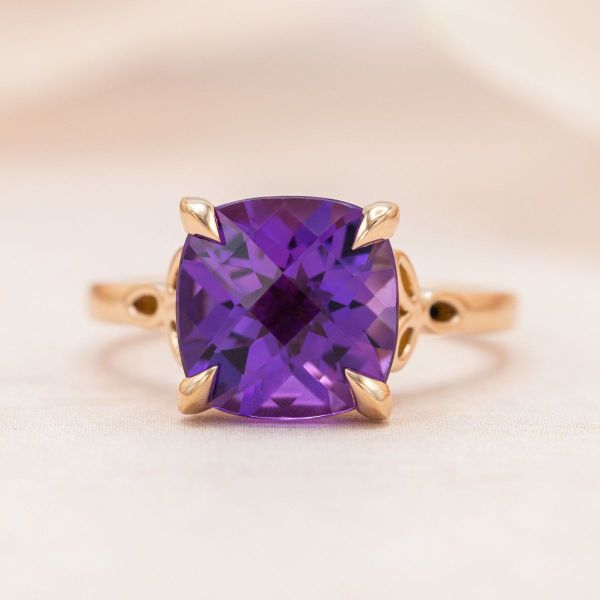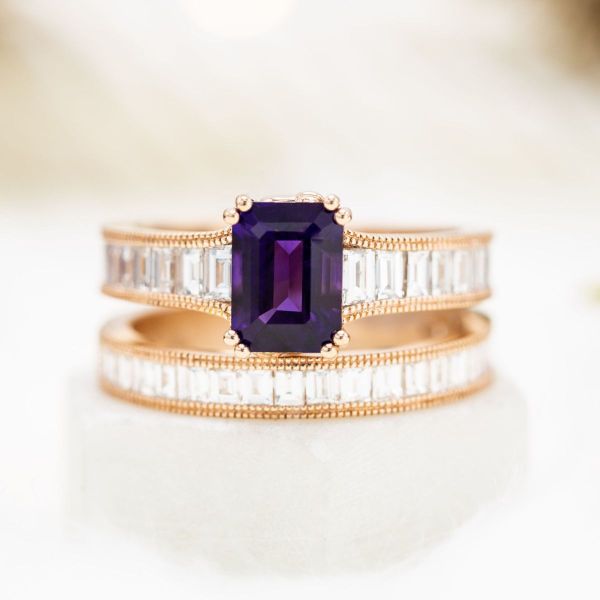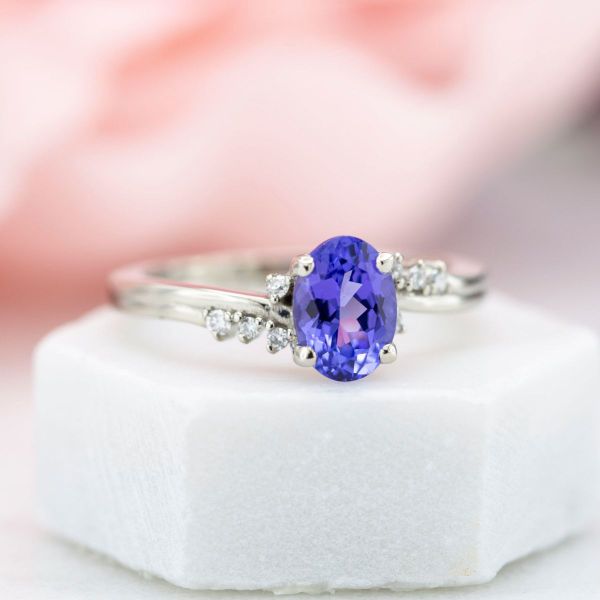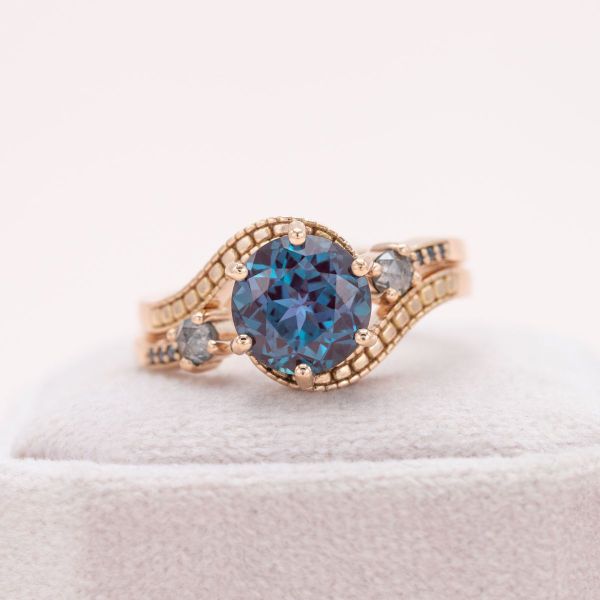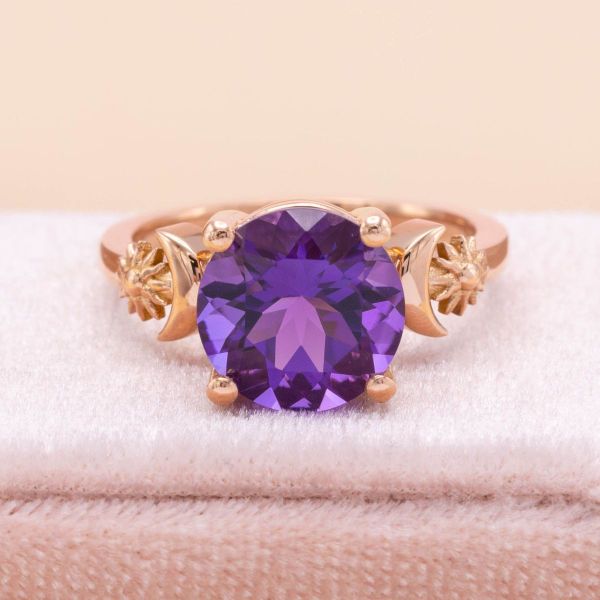Gemstone Knowledge
Is amethyst a good choice?
Amethyst is a February birthstone with spiritual ties that comes in shades of royal purple, but is it a good fit for your engagement ring?
Is amethyst a good choice for your engagement ring?
If you have a passion for purple or a birthday in February, you may be eyeing amethyst as a potential stone for your engagement ring. Amethysts can add a splash of vibrant color to your ring, and they’re ideal for couples seeking a stone with deeper meaning. Carved into amulets for protection and healing in Ancient Egypt, amethysts were also a favorite of royals in the Middle Ages with their purple color signifying nobility. Amethyst’s soothing color is said to bring peace and balance to those who wear it, and its ties to Valentine’s Day make it a romantic pick!
But, stories and symbolism aside, is amethyst a practical choice as a center stone for engagement rings? Let’s take a closer look at this mystical purple stone and highlight a few reasons you might want to choose it for your engagement ring.
Reasons to choose amethyst
Its vivid purple color
When we think of amethyst, many of us probably imagine a very specific hue of purple. But, amethysts aren’t so one dimensional, and just like famous purple-inspired songs Deep Purple, Purple Rain, Purple Haze, and Flying Purple People Eater, each shade offers a unique take on the purple theme. While its most common hue is the deep, royal purple we all know and love, its hues can range from a light lilac to a dark reddish purple, with the most sought after amethysts holding that deep purple color with violet or red undertones. Amethyst is a form of quartz, and its color comes from iron and other trace elements as well as natural irradiation. But don’t worry: that irradiation occurs while the stone is still deep within the earth and well before it reaches your finger, so no need to worry about growing a third arm or anything!
Amethysts can have light or dark tones, but many couples prefer darker toned stones as they provide depth and more intense color. In fact, because amethyst is relatively affordable and easy to source, most couples opt for those deeply saturated purple tones to ensure their center stone has high-quality color!
There are several amethyst color variations that are so well known that they actually have names. "Siberian amethysts" are deep purple with flashes of red and blue, and they're also exceptionally rare. On the other side of the purple spectrum, "Rose de France" amethysts feature pinkish violet or lilac hues.
It’s fairly durable and easy to clean
So can amethyst handle the tough job of being a center stone in an engagement ring? For the most part, yes! Amethyst has a Mohs hardness scale of 7, so it can withstand daily wear pretty well. It also has no “cleavage” or areas of weaker molecular bonds, so amethyst is more resistant to breakage. Just keep in mind that dust is also made of quartz, which means your amethyst can scratch more easily than other common engagement ring stones (like aquamarine and sapphire) if not cleaned or cared for properly.
Amethyst can be cleaned at home with warm water and a soft toothbrush, but we recommend professional inspections for your ring every few months just to make sure it’s in tip-top shape. While it’s still durable, amethyst is sensitive to extreme heat, so avoid ultrasonic cleaners and be sure to remove your ring when doing household activities that involve high heat (just in case!).
Amethyst is a sentimental center stone
We have an idea of what a diamond symbolizes in an engagement ring, but what does it mean to choose a purple stone like amethyst? It’s actually a deeply meaningful pick! A traditional February birthstone, amethyst is the perfect choice for a partner with a February birthday, or it can symbolize the month you met, proposed, or even plan to get married. Speaking of February, let’s not forget that this is also the month of Valentine’s Day, only one of the most romantic holidays in modern times! Legend has it that St. Valentine even wore an amethyst ring carved with Cupid’s likeness. It doesn’t get more romantic than choosing an amethyst for your engagement ring: the ultimate symbol of your eternal love for your partner. *sigh*
Amethyst is also thought to promote clear thinking and serenity, things that are completely necessary for getting through all that meticulous wedding planning. Some cultures even believe amethyst has healing properties, supporting clear skin and good digestion as well as balancing hormones. To be clear: choosing an amethyst for your engagement ring isn’t a substitute for yearly check ups with your physician, but it’s a sweet sentiment that can signify your desire for a long and healthy life with your beloved!
It’s relatively inexpensive
There’s plenty of amethyst to go around, and crystals grow to large sizes, so you’re likely to find decent-sized stones in whichever hue you desire. And if you’re wondering how an amethyst center stone stacks up to a traditional diamond engagement ring in terms of price, it’s the clear winner when it comes to affordability. Amethyst’s price per carat rises gradually and not exponentially, so you can choose a larger stone on a tight budget. A 1 carat amethyst costs roughly $125-$200, and a 5 carat stone is about $250-$600. If you’re feeling extra bougie, you can even find 10 carat amethysts for around $300-$900! Amethyst is a great way to add color to your engagement ring while saving your cash for those bigger budget items that come with a wedding.
It’s stunning in any shape or setting
We might think of purple as a tough color to match, but amethyst is actually rather versatile, suiting most metals and complementing other colored gemstones as well as diamonds. The metal you choose for your setting can impact the overall look of your amethyst, bringing out different facets of its overall color. White metals like platinum and white gold foster those frosty purple tones that give your ring a deeper hue, while yellow and rose gold can highlight softer pink and lilac shades within your stone and give it a warmer appeal. Because they can be deep in color, amethysts also work great as accents for light colored stones like diamonds, opals, and pearls, and they look particularly vibrant when paired with stones that have contrasting colors like emeralds and citrines.
Overall, fancy shapes are better for colored stones like amethyst. Compared to diamonds—where the goal is a colorless sparkle—these shapes give light more time to bounce around colored stones for a vivid display of their hues. Amethysts can be found in most cuts and shapes, but brilliant cuts like princess and Asscher are spectacular for deepening the hue of lightly toned amethysts. On the other hand, shallow designs—like oval and marquise—show off the strong color of darker stones.
If you want a shape that appears larger, round brilliants are always a top choice for looking bigger and fuller on any finger, but most elongated shapes will do the trick as well. Amethysts can be found in a host of longer silhouettes, looking just as mesmerizing in emerald cuts as they do in pear, marquise, or oval cuts. Just remember that a step cut like the emerald silhouette will show off more of your amethyst’s color, whereas a brilliant cut will bring out more sparkle!
Color alternatives
Ametrine
If you dig those deep purple hues but want something a little more avant-garde, ametrine may be the answer to your dilemma. Like a classy Hollywood couple, ametrine combines the names of two variations of quartz—amethyst and citrine. Ametrine features a dual color scheme with bands of both rich purples and sunny yellows for a hot/cold combination that makes for a striking engagement stone. You’ll typically find ametrine cut into emerald or “fantasy” cuts, since these are the best shapes for showing off those competing hues and mosaic sparkle. Eye-clean, large ametrine is fairly easy to find, and prices are rather affordable. Plus, it still has a Mohs hardness of 7, so it’s equally durable when compared to amethyst.
Tanzanite
If you want to stick with a purple stone, tanzanite is a popular choice. It has nearly the same durability as amethyst, ranging from 6 to 7 depending on the individual stone. Colors can vary from blue-purple to bright violet hues, offering cooler purple-inspired shades with some potential for color change and pleochroism! Just keep in mind that tanzanite is rare, so it’s pricier than amethyst. As such, you may have to make room in your budget or choose a smaller center stone to accommodate the extra expense. If you want to make a ring with various shades of purple, combining tanzanite and amethyst as accent stones can bring together warmer and cooler shades of this royal color for a completely unique look!
Alexandrite
Some couples have a hard time choosing just one color for their engagement ring, so if you’re feeling unsure you can always take a look at color shifting alexandrite. This mesmerizing stone is a sturdy 8.5 on the Mohs scale, providing solid durability on top of its beautiful color. There isn’t necessarily one hue that describes alexandrite’s appeal–it appears to change color in different lighting, ranging from green, blue, or teal under bright lights to red, purple, or pink in dimmer light sources. It’s a pricey stone as it’s naturally very rare, but advancements in gemological technology have made it easy to produce lab alexandrite for a fraction of the cost!
Picking amethyst for your engagement ring
Affordable and up to the task of withstanding day-to-day wear, amethyst can definitely hold its own as a center stone. Its signature deep purple tone offers some seriously regal appeal, and you’ll probably feel like a princess anytime you wear your amethyst engagement ring (which we hope is forever!). While amethyst looks amazing at the heart of a ring, we also love when couples use it as accents to create an entirely new look. Take a peek at the impressive designs some of our couples have come up with below, and be sure to reach out to our team to start your custom engagement ring journey today!
About CustomMade
CustomMade designs and creates one-of-a-kind, custom engagement rings and fine jewelry. Each piece we create is inspired by you, designed for you, and made just for you.
